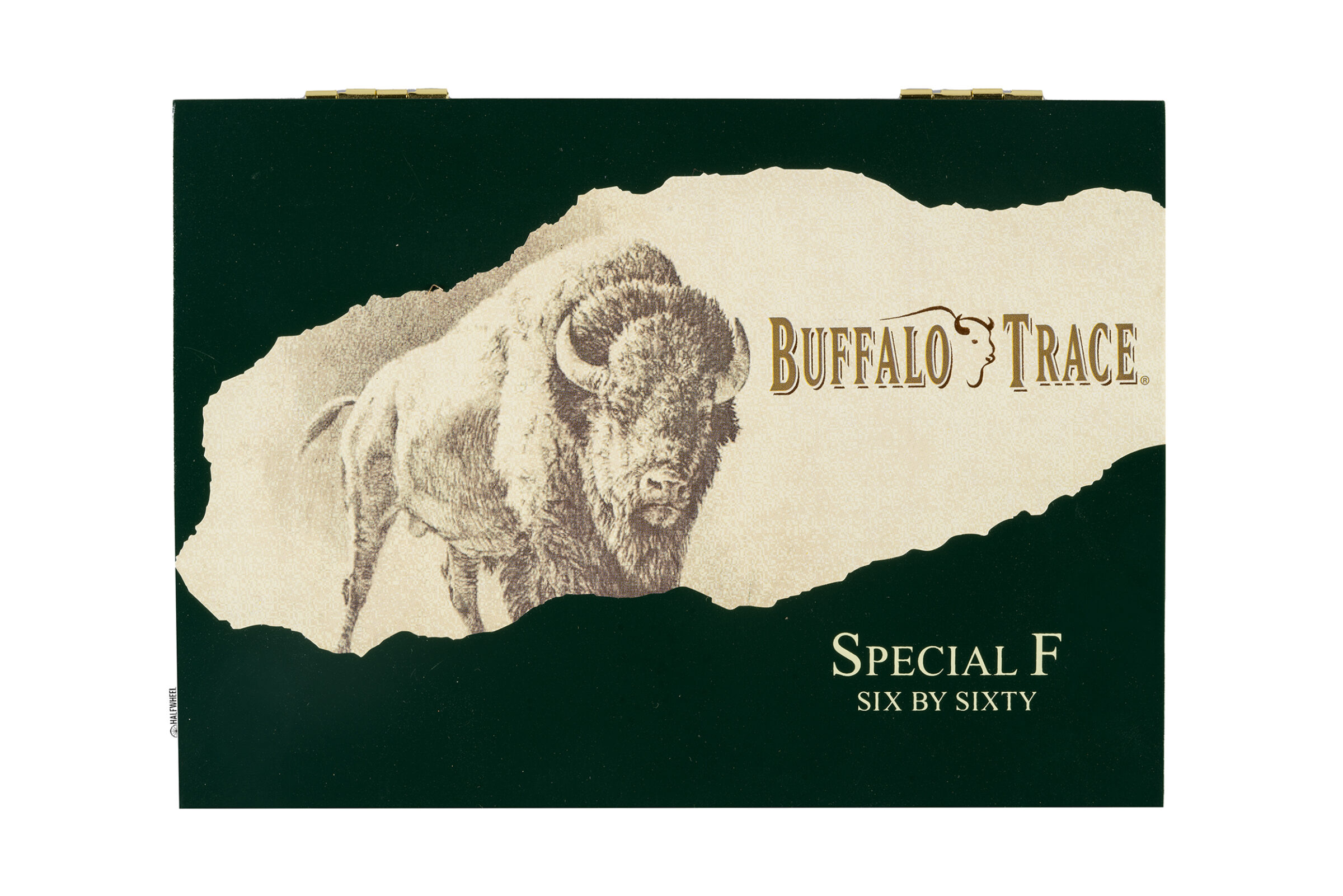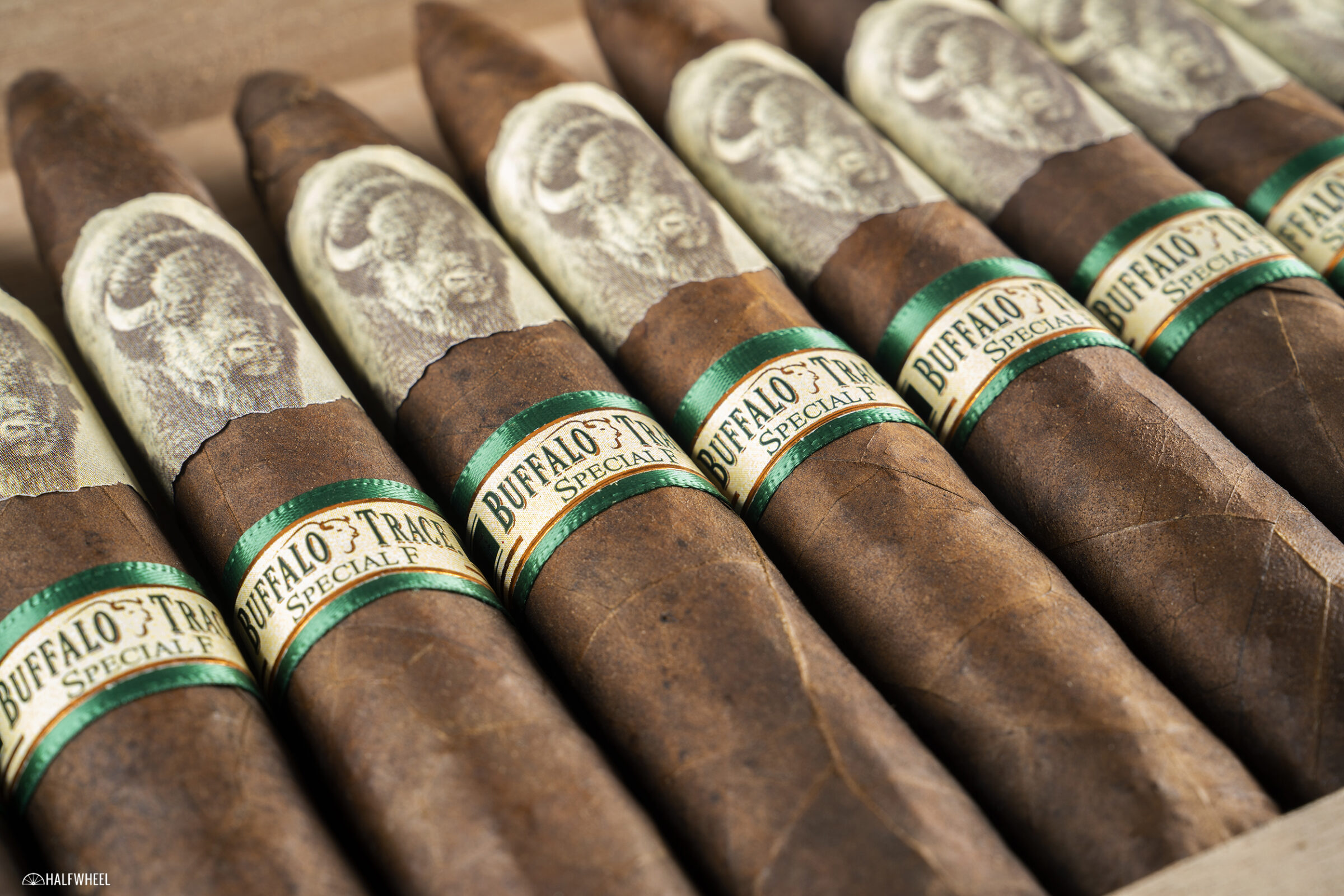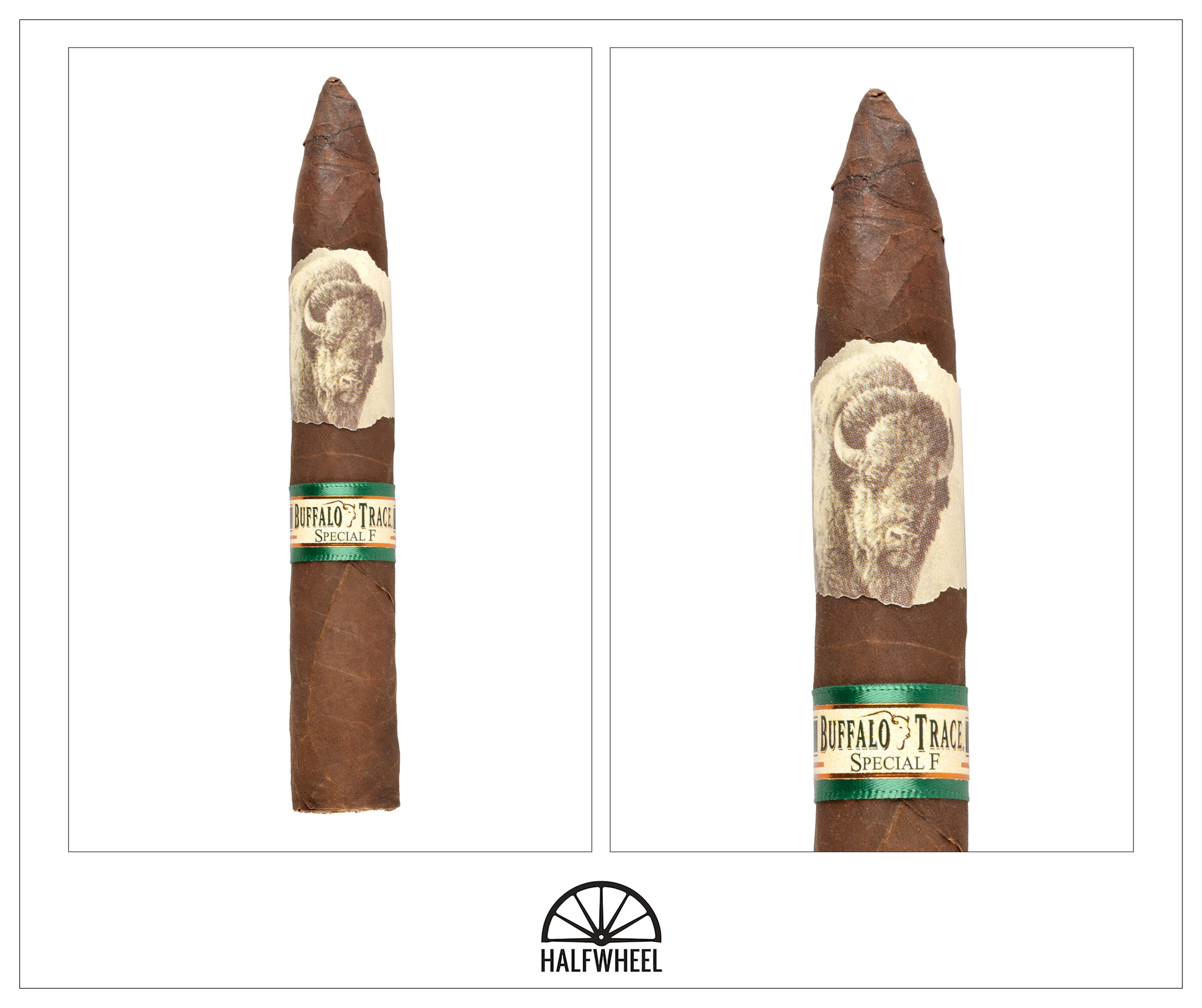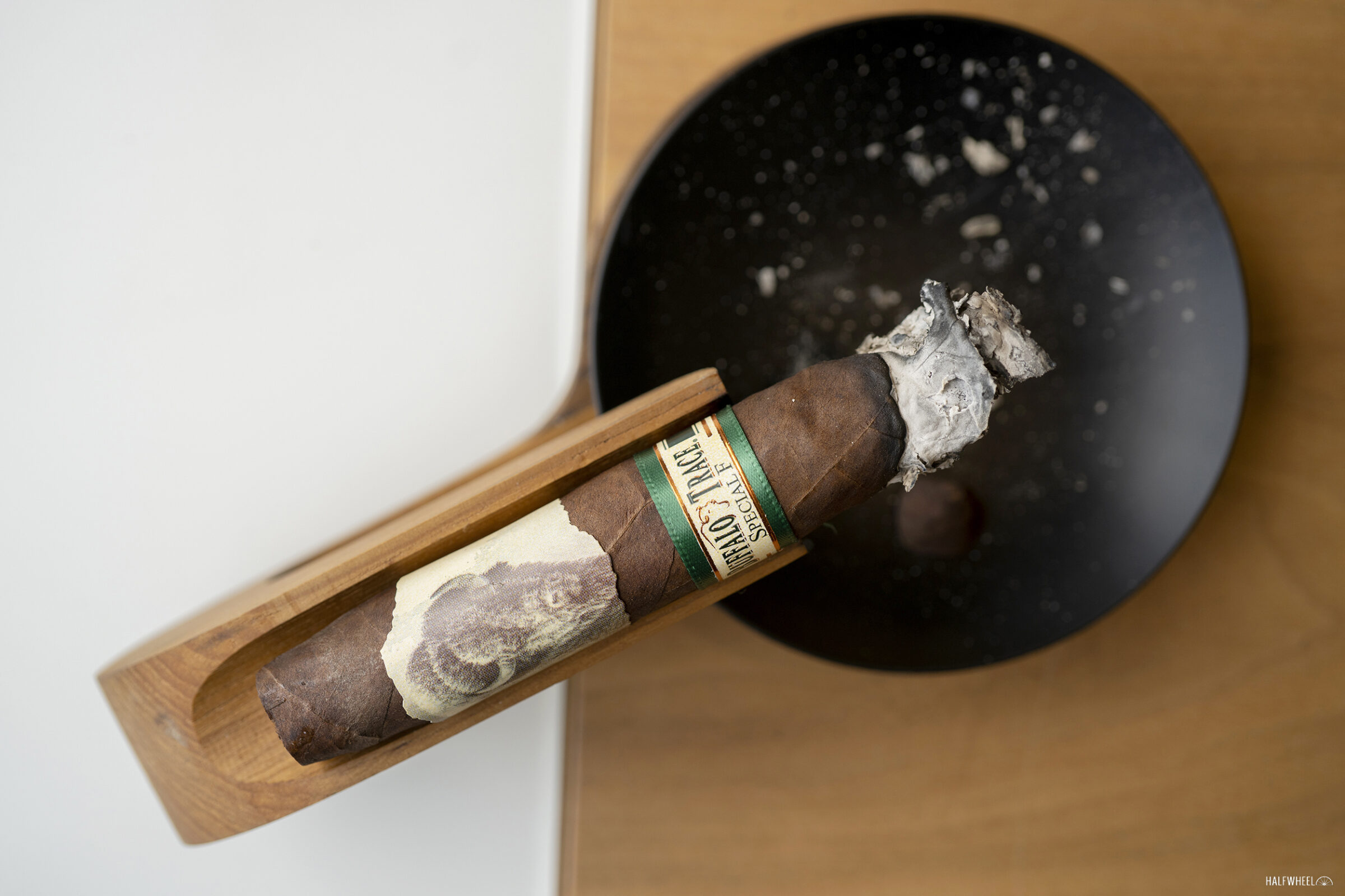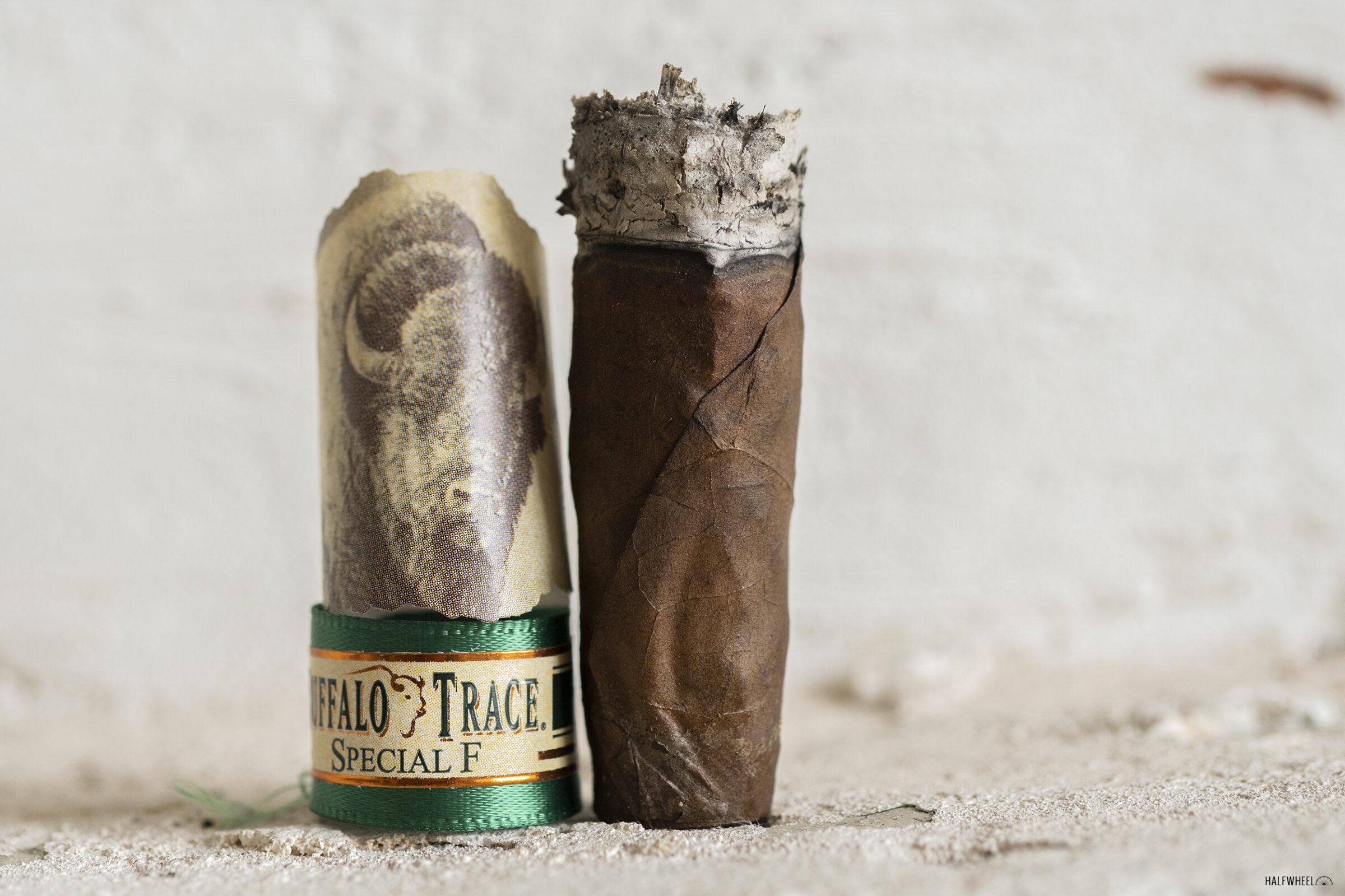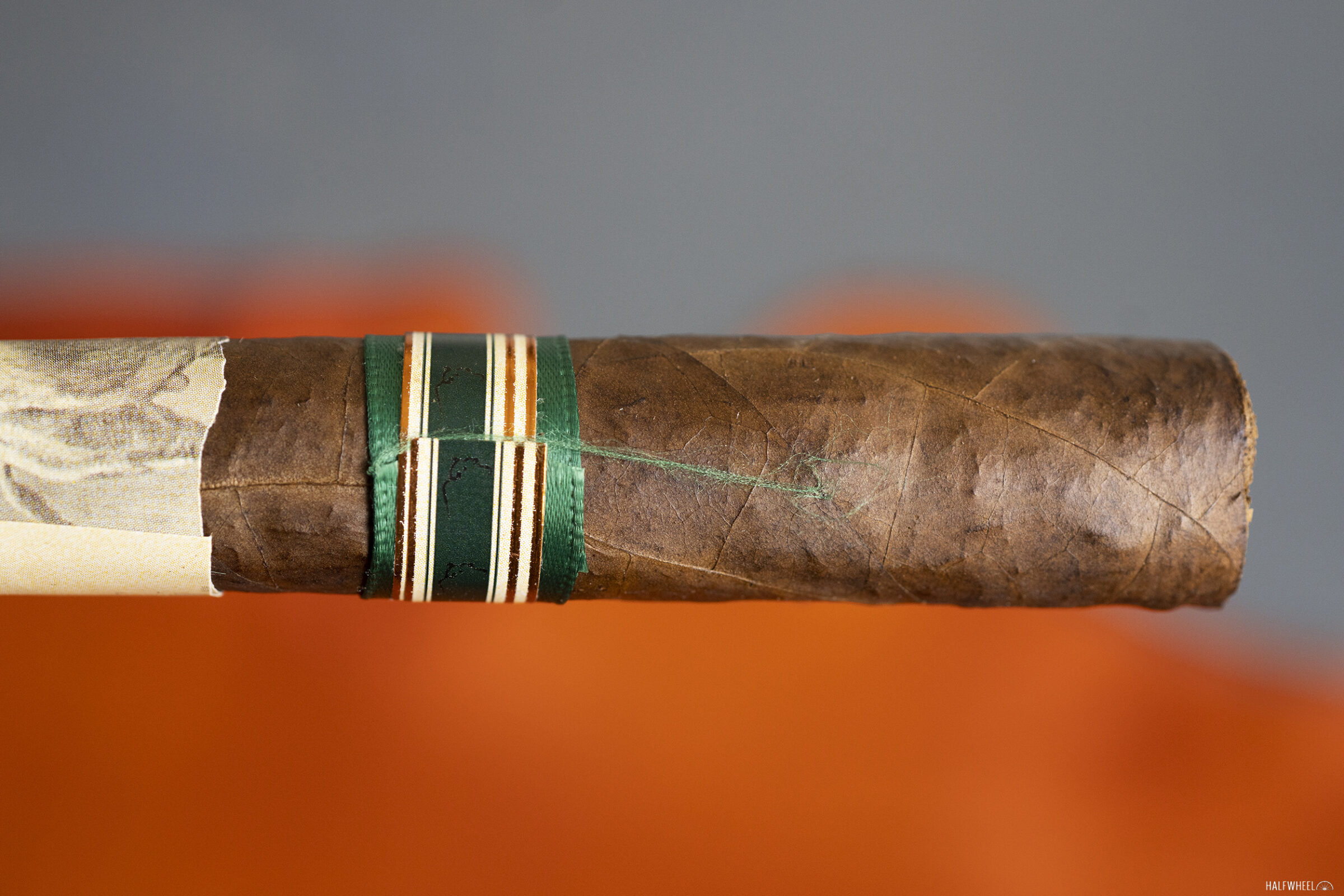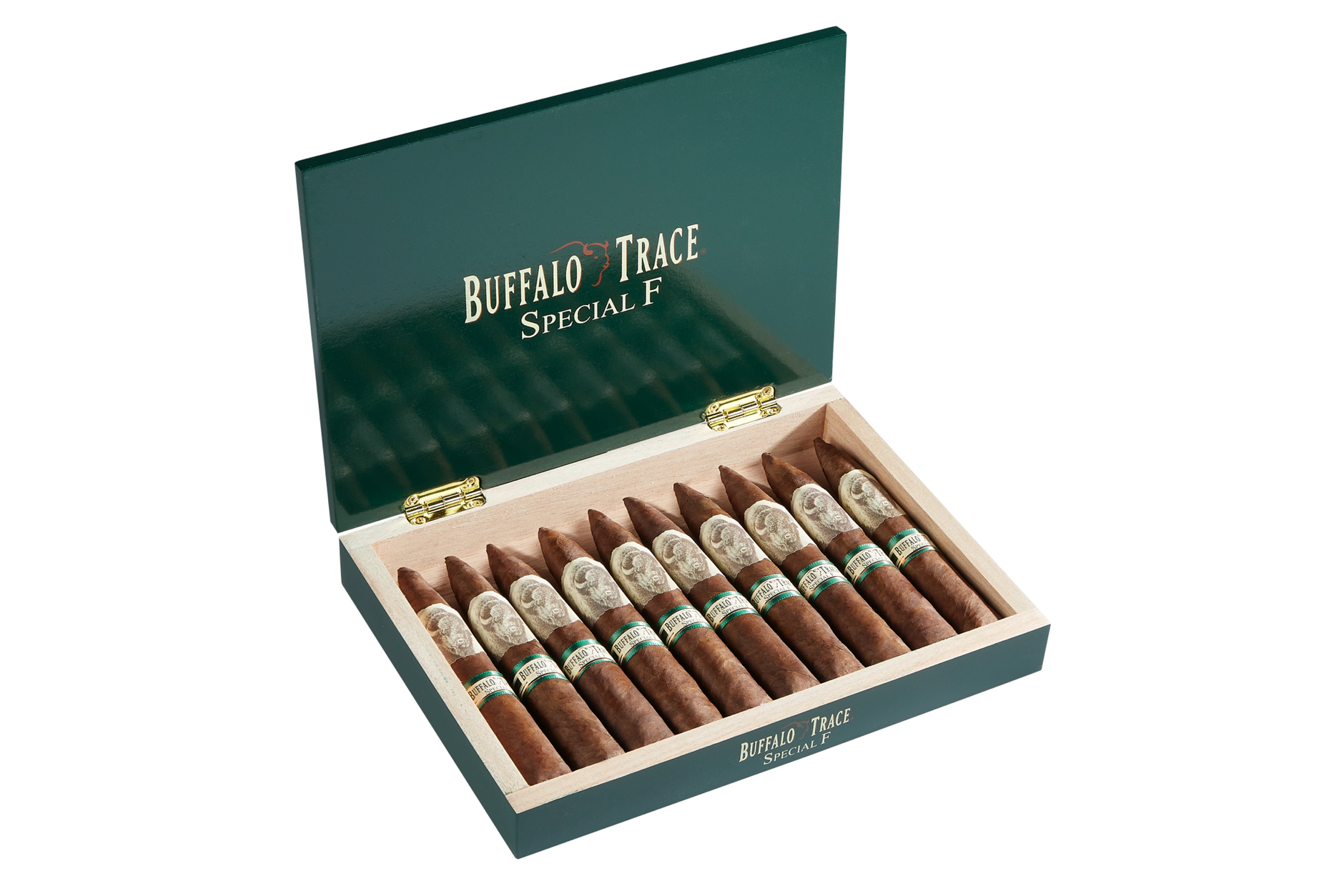In 2021, Scandinavian Tobacco Group (STG)—parent of General Cigar Co., Forged Cigar Co., Cigars International and others—announced a partnership with Sazerac & Co., the liquor company that owns the Buffalo Trace Distillery. Since then, the two companies have teamed up for six different cigar releases that have each been branded with one of Sazerac’s whiskey brands.
The most recent release was announced last September, the Buffalo Trace Special F. This is the second time that the Buffalo Trace brand was selected for one of these projects, the debut cigar from the partnership was simply called Buffalo Trace and offered in three sizes. This cigar is listed as the same blend components—an Ecuadorian Sumatra wrapper over a Brazilian Arapiraca binder and fillers from the Dominican Republic and Nicaragua—but the binder was aged for six months in spent bourbon barrels.
“With Buffalo Trace Special F, we set out to explore the effect that extended barrel aging would have on the binder leaf and are extremely pleased with the results,” said Kevin Irvine, product coordinator of STG’s Online and Retail division, in a press release when the cigar was announced. “The brown sugar and toffee nuances that have won Buffalo Trace Bourbon critical acclaim are present in the cigar, in the most subtle and intriguing of ways. This is an amazing cigar and we believe it will sell out quickly.”
The Special F is offered in a single 6 x 60 torpedo size that is sold in boxes of 10 cigars.
It’s offered through Meier & Dutch, which is the wholesale distribution arm associated with Cigars International, meaning that it’s offered at STG’s various stores and can be purchased by other retailers.
- Cigar Reviewed: Buffalo Trace Special F
- Country of Origin: Dominican Republic
- Factory: General Cigar Dominicana
- Wrapper: Ecuador (Sumatra)
- Binder: Brazil (Arapiraca)
- Filler: Dominican Republic & Nicaragua
- Length: 6 Inches
- Ring Gauge: 60
- Vitola: Torpedo
- MSRP: $11 (Box of 10, $110)
- Release Date: September 2022
- Number of Cigars Released: Regular Production
- Number of Cigars Smoked For Review: 3
The Buffalo Trace Special F has a trompeta-like shape meaning that the thickness tapers the full length of the cigar. The wrapper has a dark hickory color that is pretty consistent save for some of the veins, which are noticeably lighter than most of the surface area. While the wrapper leaf doesn’t appear to be gnarly, the cigar’s appearance is a bit rough due to how bumpy the roll is and some wrapper stretching and dents. The aroma from one cigar has some fire-cured tobacco vibes over some acrid barnyard. The other two cigars avoid the smell of fire-cured tobacco, which means the acidic barnyard has more space to shine. The foot is stronger—full as opposed to medium-plus—with sweet chocolate over barnyard, earthiness, mulch and something that reminds me of the smell of paper coming out of a commercial laser copier. Cold draws have flavors that remind me of an ice cream cone, though sometimes it’s less sweet and closer to a generic cereal, over earthiness, nuttiness and some dryness. One cigar has a small part of the wrapper come undone upon cutting, while another cigar has an open draw.
Lots of bread flavors sit over mineral flavors and some creaminess. While the flavor is medium-plus, it does seem like the cigar is a bit timid during the first few puffs. The flavor intensity increases though I still find the profile to be rather basic. It’s a simple but enjoyable mixture of earthiness, oak and creaminess leading some mineral flavors, a mild peanut flavor and some black pepper. Tartness, saltiness, sharpness and sweetness come and go as accents to help shake things up. The finish is very similar, though there are some minor changes. The mineral flavors and oak edge out earthiness. Behind that trio are black pepper at the back throat, creaminess and saltiness. Oddly, the finish is more intense than the first few moments when the smoke is in the mouth. Retrohales have nuttiness over meatiness, oak and an increased amount of saltiness. Again, the finish is similar: oak and creaminess followed by black pepper and saltiness. Flavor is medium-plus, body is mild-medium and strength is medium. Two cigars suffer from the need for touch-ups due to uneven burns, while the third cigar is burning very well.
While I think that the tartness reduces itself in the second third, the profile is getting rougher thanks to an uptick in both black pepper and some isolated harshness. Again, this is a profile that is generic but enjoyable. Crisp oak and cedar sit over earthiness, coffee creamer, nuttiness and black pepper. While the flavors are remarkably consistent from puff to puff, there are differences regarding how rough or smooth each puff is. The finish has damp earthiness, crispness, creaminess, black pepper, nuttiness and some leather. Compared to when the smoke is in my mouth, the finish presents the flavors in a more isolated manner. Retrohales have black pepper, creaminess, leather, white pepper and mushy earthiness. Similar to the first third, the finish has a shorter list of flavors: black pepper over oak and leather. Flavor is medium-full, body is medium and strength is medium. Two cigars need regular touch-ups to help with uneven burns and smoke production and the second cigar I smoke ends up going out completely. That leads to more roasted and charred flavors, though it also increases the flavor intensity closer to full.
The final third of the Buffalo Trace Special F is the most unique of the bunch, though I’m not sure that’s saying much. There’s dry earthiness and nuttiness, both accented by some roughness that can sometimes present itself as toastiness. Secondary flavors include citrus, a mushier earthy flavor and a harsh mineral flavors. The mineral flavors lead the dance during the finish, followed by earthiness, toastiness and minor amounts of both herbal flavors and tartness. Retrohales have more roasted flavors than toasty flavors along with black pepper, lime, white pepper and some herbal flavors. They finish led by either toastiness or black pepper, though creaminess and earthiness serve as secondary notes. Flavor is medium-full, body is medium-plus and strength is mild-medium. Not surprisingly, the two cigars with prior construction issues continue to have combustion issues, while the final cigar avoids a single touch-up though smoke production has thinned out.
Final Notes
- After finishing smoking the cigars for this review, I reread the news story about this cigar and was surprised to see the cigar listed at 60 ring gauge. Because this cigar tapers the full length of the cigar, the only part of the cigar of this cigar that is 60 ring gauge is the very bottom. Obviously, being a belicoso, it won’t feel like a 60 ring gauge parejo in the mouth, but it also never felt like a 60 ring gauge cigar in the hand.
- I had also forgotten that the binder was aged in bourbon barrels. I did not detect any barrel-like flavors.
- The cigars in the box noticeably varied in length, which is relatively rare. The shortest cigar measured 5.87 inches long, while the longest cigar measured 6.1 inches. I randomly grabbed three cigars from the box to smoke, none of which were at the end of the length spectrum.
- The reason why lengths of the cigars in a box are typically very consistent is that the cigars are bunched and rolled longer than they intend to be. Once the cigars are rolled, but before the cigars go into the aging room and packaging, the cigars are placed on a cutter or chopper. The cap of the cigar is placed against a stopper of sort and the other end has a blade that is attached to a handle. Each cigar is then cut to length and, in theory, should end up being nearly identical in length.
- I suspect the copy paper smell is due to the box, which has some of that smell inside.
- The aroma of the first cigar I smoked smelled more like a blunt than a typical cigar. That was present on the other two cigars.
- The first two cigars I smoked had regular combustion issues, more uneven burns than smoke production issues. Despite my best efforts to keep it burning, the second cigar I smoked went completely out and required a relight. I think there’s a case to be made that it produced a more enjoyable flavor profile, though it wasn’t a dramatic improvement. It added some toasty flavors and upped the intensity slightly, though I wouldn’t recommend purposely letting the cigar go out. The final cigar I smoked needed just one touch-up.
- While the ash was firm in the sense that it could build up to a pretty long length, it was very flaky.
- There are many cigars that come with ribbons as a foot band and there’s a smaller number that have used ribbons as the main band, but I can’t think of another cigar that has used the ribbon as a secondary band. This not only has that unique feature but there’s another even smaller band that sits on top of it.
- While it’s unique, I don’t think it’s well-executed. Unfortunately, the majority of the cigars in the box we purchased had ribbons that were frayed. Given that I wanted to avoid having the ribbons catch fire, that meant I needed to cut off the frayed portions with a knife or remove the bands prior to smoking.
- The first Buffalo Trace cigar line has the same three band elements but in a much more common fashion: main band, secondary band and a green ribbon on the foot.
- CBS recently produced this short feature on Buffalo Trace that I happened to watch.
- General Cigar Co. and Cigora—which are owned by the same parent company as Cigars International—advertise on halfwheel.
- Cigars for this review were purchased by halfwheel.
- These cigars burned epically slow and the final smoking time was two hours and 45 minutes on average.
- Site sponsor Cigars Direct carries the Buffalo Trace Special F
While this is not a cigar that will be included in our annual Top 25, I suspect that wasn’t the objective. Given the marketing tie-in, my guess is that this cigar was blended more to be a cigar that can appeal to a wide range of consumers than one that has the absolute best flavor. If asked to put together a list of the most stereotypical flavors found in cigars, this is more or less the list. It’s done in a way where no one flavor ever gets too overwhelming, most of the flavors are there from start to finish, but there are enough changes to avoid it being extremely monotonous. Unfortunately, the construction left a fair bit to be desired, especially given what appears to be a lack of heavy tobacco.


